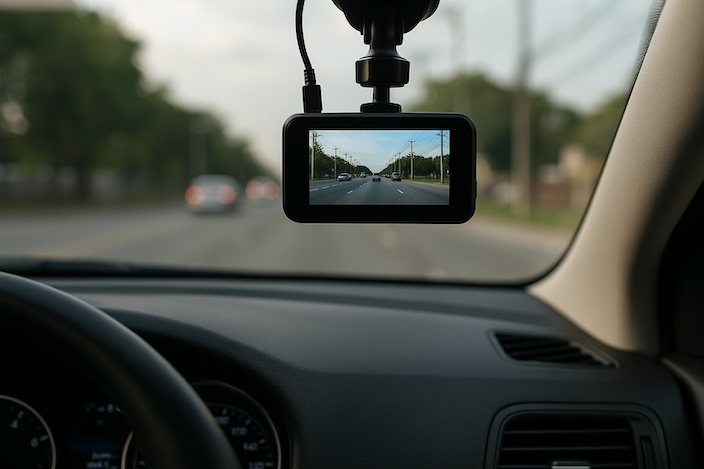How Dashcams Are Changing the Way Accident Cases Are Won

In recent years, dashcams have evolved from niche gadgets into vital tools in car accident litigation. In Maine, these small cameras are reshaping how investigators, attorneys, and courts view crash scenes — and giving victims a powerful way to show what really happened.
Why Dashcams Matter Now More Than Ever
Traditionally, crash reconstructions relied on physical evidence (skid marks, vehicle damage), eyewitness testimony, and police reports. But human memory is fallible, and physical clues only tell part of the story. Dashcams provide a continuous, objective visual record of the moments leading up to, during, and after a collision.
- Dashcam footage can show the precise timing of braking, lane drift, turns, and road conditions — details that often become points of dispute in injury claims.
- Video evidence helps discourage insurance companies from denying claims or offering lowball settlements, because the images often speak more loudly than statements.
- Judges and juries tend to view dashcam footage as highly credible, especially when it is authenticated and unedited.
In Maine, using dashcam video as part of a crash case requires following legal rules, preserving evidence, and building a strong narrative — but the advantages are real.
Are Dashcams Legal in Maine?
Yes — dashcams are legal in Maine so long as they do not obstruct the driver’s view of the road.
Dashcam footage can be admissible in Maine personal injury cases, but the party wishing to use it must authenticate the video (prove it is what it claims to be) and show it hasn’t been tampered with.
One caveat: if a dashcam records audio without meeting consent or privacy rules, that portion of the recording may be contested.
How Footage Strengthens Maine Crash Cases
Here’s how dashcams are changing tactics in Maine injury litigation:
1. Clarifying Fault and Timeline
Dashcams can capture exactly when a driver collided, how fast they were going, or whether they drifted across a lane before impact. That clarity makes it harder for the defense to dispute key facts.
2. Showing Context and Conditions
Beyond the collision itself, dashcam video can show weather, lighting, traffic flow, and other contributing factors — all of which help build a fuller picture.
3. Meeting or Beating Defense Narratives
In many cases, the defense will try to shift blame or cast doubt. A clear video can undercut those tactics. If their version of events conflicts with the footage, they lose credibility.
4. Strengthening Settlement Leverage
With compelling dashcam evidence in hand, plaintiffs’ attorneys can push for stronger settlement offers — insurance adjusters often prefer to avoid letting a jury see an unambiguous video.
5. Preventing Evidence Tampering
Video from a dashcam is harder to alter post-crash than witness statements. That permanence strengthens the chain of custody and integrity of evidence.
Limits and Risks of Dashcam Evidence
Dashcams are powerful — but not foolproof. Attorneys must navigate several challenges:
- Poor Video Quality: Blurry or low-light footage may be inadmissible or inconclusive.
- Narrow Field of View: A dashcam can miss part of the incident, such as side impacts or off-camera movement.
- Self-Incrimination: If your own dashcam shows you making a mistake (speeding, distracted driving), the defense may use it against you.
- Data Overwriting: Dashcams often loop and overwrite older video unless the crash is manually preserved.
- Access to Other Party’s Footage: If the dashcam belongs to the at-fault driver, you may need a court order in discovery to obtain it.
- Disputes Over Editing or Tampering: The defense may challenge the authenticity, claiming the video was cut or altered.
Steps to Use Evidence Effectively in Maine
To maximize the benefits of dashcam footage, follow these best practices:
- Preserve the Recording Immediately
As soon as the crash occurs, secure the video file so it doesn’t loop away or get overwritten. - Make Backups
Save multiple copies (e.g. external drive, cloud, image files) to protect against accidental deletion. - Avoid Editing or Altering
Don’t trim footage or add special effects; these actions can invalidate your ability to use it legally. - Time-Stamp and Metadata
The embedded date/time and GPS metadata help authenticate the footage in court. - Combine with Other Evidence
Use dashcam video in conjunction with witness testimony, police reports, medical records, and accident reconstruction. - Hire Experts for Analysis
Video experts can verify authenticity, gauge distances, and correlate the video’s timeline with crash mechanics. - Introduce Footage Strategically
Your lawyer should frame how and when the footage is introduced so it guides the factfinder’s understanding.
How We Use Dashcam Evidence in Maine Cases
At Peter Thompson & Associates, we incorporate dashcam video into our approach when available and relevant. Here’s how we do it:
- We move quickly to write preservation letters and file discovery requests to ensure the footage isn’t lost.
- We employ forensic video analysts to validate and explain what the footage shows.
- We juxtapose the video with medical records, scene photos, and expert reconstruction to build a compelling narrative of injury causation.
- We use the video as leverage during settlement negotiations and — when necessary — present it in court to persuade juries.
Dashcam evidence alone rarely wins a case — but when properly used, it can tip a close case in your favor.
Conclusion
Dashcams have transformed Maine personal injury law by giving injured parties a clearer path to proving what really happened. These cameras serve as impartial witnesses, and when handled properly, they can tip investigations, negotiations, and trials in the right direction.
If you or a loved one was injured in a crash where dashcam footage exists — or you suspect video evidence was recorded — Peter Thompson & Associates can help. Our team will locate, preserve, analyze, and integrate that evidence into a compelling claim.
Contact us today for a free consultation. Let us help you turn technology into accountability — and justice.

